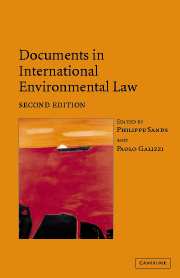Book contents
- Frontmatter
- Contents
- Preface
- PART I General instruments
- 1 Stockholm Declaration of the United Nations Conference on the Human Environment, 16 June 1972
- 2 UN General Assembly Resolution 37/7 on a World Charter for Nature, 28 October 1982
- 3 Rio Declaration on Environment and Development, 16 June 1992
- 4 Draft Articles on Prevention of Transboundary Harm from Hazardous Activities, 2001
- PART II Atmosphere
- PART III Oceans: global
- PART IIIB Oceans: regional
- PART IV Freshwater resources
- PART V Biodiversity
- PART VIA Hazardous substances and activities: nuclear
- PART VIB Hazardous substances and activities: pesticides
- PART VIC Hazardous substances and activities: waste
- PART VII Human rights and the environment
- PART VIII War and the environment
- PART IX Trade and the environment
- PART X Environmental impact assessment and access to information
- PART XI Liability for environmental damage and breaches of environmental obligations
- PART XII The Antarctic
2 - UN General Assembly Resolution 37/7 on a World Charter for Nature, 28 October 1982
Published online by Cambridge University Press: 05 June 2012
- Frontmatter
- Contents
- Preface
- PART I General instruments
- 1 Stockholm Declaration of the United Nations Conference on the Human Environment, 16 June 1972
- 2 UN General Assembly Resolution 37/7 on a World Charter for Nature, 28 October 1982
- 3 Rio Declaration on Environment and Development, 16 June 1992
- 4 Draft Articles on Prevention of Transboundary Harm from Hazardous Activities, 2001
- PART II Atmosphere
- PART III Oceans: global
- PART IIIB Oceans: regional
- PART IV Freshwater resources
- PART V Biodiversity
- PART VIA Hazardous substances and activities: nuclear
- PART VIB Hazardous substances and activities: pesticides
- PART VIC Hazardous substances and activities: waste
- PART VII Human rights and the environment
- PART VIII War and the environment
- PART IX Trade and the environment
- PART X Environmental impact assessment and access to information
- PART XI Liability for environmental damage and breaches of environmental obligations
- PART XII The Antarctic
Summary
Editorial Note
The World Charter for Nature (adopted by a vote of 111 in favour, 1 against (USA) and 18 abstentions) seeks to have its guiding principles given effect through national legislation and international practice (Articles 14 and 22). These principles include: respect for nature (Article 1); safeguarding of habitats necessary to maintain sufficient population levels for the survival of all life forms (Article 2); protection of unique areas, representative samples of all ecosystems, and of habitats of rare or endangered species (Article 3); and the utilisation of man's environment so as to maintain ‘optimal sustainable productivity’ while maintaining the integrity of all ecosystems and species (Article 4).
In order to realise these principles, the Charter sets out several specific requirements, including, taking into account the effects of economic development on natural resources and the environment (Article 6–9); not wasting natural resources (Article 10); controlling activities which risk harming nature by using ‘best available technologies’, avoiding high risk activity, and restoring degraded areas (Article 11); and avoiding discharging pollutants (Article 12). To further implement the Charter's objectives, States are also required to take the following action: disseminate information on nature (Article 15); encourage public consultation and participation in all planning decisions (Article 16); provide funding for the conservation of nature (Article 17); and make available remedies for harm to a person's environment (Article 23).
- Type
- Chapter
- Information
- Documents in International Environmental Law , pp. 11 - 16Publisher: Cambridge University PressPrint publication year: 2004



